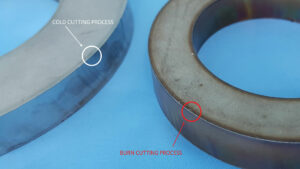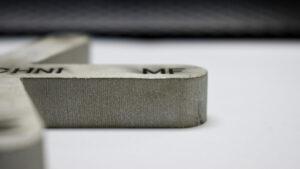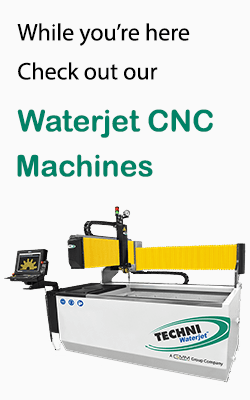Everyone has a basic familiarity with what is metalworking. Metalworking processes have been driving the world even before the earliest civilizations. In fact, eras of ancient times were named after metalworking processes they used, such as the Iron Age and Bronze Age.
Metalworking processes have evolved into a complex science in this industrial age. The industrial revolution has incorporated exponential growth in the scale of modern metalworking processes. Additionally, the technologies used in these processes have become increasingly complex.
This article will provide a detailed answer to the question ‘What is Metalworking?’ It will go through all the different metalworking techniques and the advantages of the process. The information provided here is invaluable to beginner hobbyists and professional metalworkers alike.
What is Metalworking?
Metalworking is the process of changing the shape of metal to fit the required application. Metalworking techniques can alter the form, area, length, thickness, shape, and even the surface finish of metal objects. The shaping can be done by force, temperature, or removing excess material from the metal objects.
Traditionally, metalworking was done by professionals in dedicated workshops. However, the last few decades saw many advancements in machining processes and technologies like CNC. This has led to metalworking becoming an integrated part of modern assembly lines.
Brief History of Metalworking
Metalworking predates earliest civilizations for a long time. Metal objects of copper have been dated back to as early as 8700 BC. Early metalworking processes were very basic, such as hammering. In later millennia, metalworking began incorporating heat to melt and reform the molten metal.
Where was metalworking invented?
The Middle East is often speculated as the region where metalworking was invented. The earliest known metal object in Israel dates back to 6000 BC. However, there is no concrete evidence of metalworking invention because ancient metalworking processes have been indicated in Southwest Asia, Greece, and Egypt.
African civilizations started working with steel around 1400 BC. In 600 BC, Copper found popular use in the American region. Fast forward two millennia, and the first iron foundries opened up in Great Britain. This became the driving factor towards the industrial revolution.
What is the Importance of Metalworking?
Metalworking processes are the basis of the operations of every other industry. Most manufacturing industries directly use materials output from one or more metalworking processes. If an industry does not use metal raw materials, it definitely uses tools and products of metalworking processes.
Different Types of Metalworking Techniques
There are many different types of metalworking processes, categorized by their class. Common metalworking classes are joining, cutting, casting, and forming processes. Let us go through all the different techniques that fall under these classes of metalworking:
Metal Cutting Processes
Metal-cutting processes divide metal sheets or blocks in multiple pieces by removing a small amount of material from the cut location. Metal cutting processes also shape metal workpieces into the desired object. The material removal can be done with force, friction, heat, or electricity. Here are some of the metal-cutting techniques:
Milling
Milling is one of the common mechanical cutting techniques. It uses high-speed rotary cutting tool to remove material from a workpiece. The workpiece is typically stationary. The cutting tools come in various shapes to fulfill the required purpose. Common types are end mills, face mills, and thread mills.
Application of a Milling Machine
- Milling machines are used to create niche features on a workpiece. The particular feature can be machined by using the appropriate milling tool.
- A milling machine tool can also remove crevices from a workpiece that are prone to corrosion.
- A milling machine can also create oversized, rectangular, and slotted holes.
Turning
Turning uses a non-rotary cutting tool working on a rotating workpiece. The workpiece for turning processes usually has circular elements. The turning process inscribes a helical path on the workpiece.
Applications of Turning Machine
- Turning machines are used to craft cylindrical components like automobile shafts, axles, and engine parts.
- Turning machine tool can create turbine housing, holes, grooves, threads, and tapers.
Grinding
Metal grinding uses rotary discs with an abrasive surface. The discs remove minimal material from the workpiece to smooth the surface. Grinding is also done to make micro-adjustments to a workpiece’s dimensions to make it fit into the required application.
Applications of Grinding
- Grinding is mainly used to remove irregularities from metal surfaces. It provides an aesthetically pleasing appeal to the surface.
- Grinding can also remove unwanted finishes due to other metalworking processes. For instance, welding causes burrs which can be removed by grinding.
- Grinding reduces the workpiece dimensions for secondary assembly.
Drilling
Drilling is one of the most common metalworking process. It uses a rotary drill bit to create holes in the workpiece. The holes can be of varying sizes based on the thickness of the drilling bit. Drilling machines have varying scales, from handheld manual options to large-scale structures operating on CNC.
Applications of Drilling
- Drilling is used to create holes for screws.
- Drilling creates cutouts for secondary assemblies.
- It can make cuts in metal for aesthetic purposes.
Threading
Threading tools create the helical line on the metal workpieces. The lines are used to fit the workpiece’s screws, nuts, and bolts. The helical grooves made by threading also help assemble two workpieces together.
Applications of Threading
- Threading machines cut grooves on tubes and pipes for plumbing assemblies.
- Threading grooves on workpieces provides the facility of screwing them together.
- Threads on the interior of holes in the workpiece help fix screws, bolts, and nuts.
- Threading machines can also create threads on screw-like parts to fix them to any object.
Filing
Metal filing is similar to the grinding process. It removes minimal amount of material from the workpiece for minute adjustments or surface finishing. Filing is also used for same applications as grinding, i.e. smoothening surface finishes. However, filing is more versatile and can easily work on surfaces where grinding wheels cannot reach.
Applications of Metal Filing
- Filing removes the burrs made during metal welding.
- Filing can also remove any unwanted abrasions on the workpiece.
- Filing can improve the accuracy of a workpiece by removing excess material in small increments.
sawing
Sawing is more commonly used for wood but also applies to metalworking processes. Metal sawing uses a blade with sharp, toothed edges. The blade is usually flexible and rotates quickly between two wheels. There are many different configurations of metal saws, such as horizontal and vertical band saws.
Application of Metal Sawing Machines
- Metal sawing is generally used for cutting down a large area of sheet metal into smaller sizes that are easy to use and transport.
shaping (or planing)
Shaping and planing are two different metalworking tools with very similar principles. Shaping consists of a cutting tool moving across a stationary workpiece. In planing, the workpiece is moved along a stationary cutting tool. Either case uses a single-point cutting tool to accomplish the job.
Application of Shaping/Planing
- The most common application of planing and sawing is cutting flat surfaces.
- These machines can make inclined surfaces.
- Dovetails are cut with planers and shapers.
Broaching
Broaching uses a moving cutting tool with toothed edges. The particular design of the cutting tool varies based on application. Broaching can be done on the exterior of the workpiece as well as its interior. Exterior broaching is known as surface broaching. Broaching done inside the workpiece is called internal broaching. A broaching machine is referred to as a broach.
Application of Broaching
- Broaching creates niche cavities such as keyholes.
- Broaching can make toothed parts like gears and splines.
Laser Cutting
Laser cutting technology uses high-energy sources of light for melting the metal. The melted material is removed with airflow, which creates smooth and clean cuts. The width of the light beam is very narrow. The accuracy of the process is very good due to the narrow beam.
Application of Laser Cutting
- Laser cutters can divide large metal sheets to manageable sizes.
- The scalability of laser cutting makes it usable in jewelry making.
- Laser cutters can design custom interior design installations.
- Healthcare products are crafted with laser cutting processes.
Waterjet Cutting
Waterjet cutting is one of the most popular metalworking process. It uses the high force of water for metal erosion and cutting. The water jet can be adjusted to any direction, making it usable for linear, non-linear, and 3-dimensional cuts. Waterjet cutting does not have thickness limits for metal objects. This provides it a huge edge over any other metalworking process.
Application of Waterjet Cutting
- Waterjet can cut thick sheet metal useful for bulk metal forming.
- Waterjet machining process is perfect for making surgical equipment and healthcare devices.
- This technology is common for the fabrication process of automobile parts.
- Scalability of waterjet machines makes them usable for large-scale structures in the marine industry.
Metal Joining Process
Joining is a metalworking process of merging two workpieces together using heat techniques. Joining processes are fundamental in every metalworking industry, be it aerospace, automobile, or electronics.
The different metal joining techniques are:
Welding
Welding is one of the most common metal joining process. Welding machines are everywhere, from small-scale workshops to large manufacturing industries. There are many types of welding, such as TIG and MIG. Welding processes melt a filler metal and use it to fuse the two workpieces together. The choice of filler material and the process of fusion varies based on the type of welding method.
Application of Welding
- Welding can join ferrous and non ferrous materials.
- Welding is extensively used for frames and exteriors of automobiles.
- Sectors like aerospace and aviation rely on welding.
- Welding is crucial for the construction industry.
Soldering
Soldering is similar to welding but on a very smaller scale. It uses a filler metal that is melted and placed between the target metals. The target metals are fused due to the high heat and the action of the filler metal. Soldering is one of the oldest metal fabrication processes, with applications as early as 5000 BC.
Application of Soldering
- Electronics industry is the most prominent user of metal soldering.
- Soldering is common for fusing and repairing jewelry.
- Plumbing also requires soldering in some applications.
Brazing
Brazing is another metal joining process similar to welding. The main defining factor of brazing is that it does not melt the workpiece materials. It melts only the filler material and pushes the molten metal between the workpieces. However, welding melts the workpiece as well as the filler metal.
Application of Brazing
- Brazing can join any metal except aluminum and magnesium.
- It is used for combining pipe fittings.
- It is the go-to process for joining metals that have uneven thicknesses.
- Brazing is used for sealing cooling and heating systems.
- Brazing fuses alloys for building solar panels.
Riveting
Riveting is a mechanical joining process. This is very different from the joining processes like welding and soldering, which are based on using molten metal. The rivets are drilled or punched into the workpieces. The tail of the rivet is then forced to expand. This creates a tight and secure joint with a lot of tensile strength.
Application of Rivets
- Riveting can fasten multiple sheet metals together.
- Rivets are common in metal bridge construction.
- Heavy-duty applications like pressure tanks and hoisting cranes use riveting.
Bolting
Bolting is a non-permanent type of metal joining process. The other processes mentioned above join materials permanently. However, bolted materials can be unscrewed and assembled again, leading to better portability and management. Bolting can use bolts, screws, and nuts.
Application of Bolting
- Heavy bolts find use in laying railway tracks.
- Water treatment and sewage treatment plants use bolting.
- Bolting is important in the marine industry for shipbuilding.
- Plumbing applications use bolting for pumps and valves.
Metal Forming Processes
The forming process relies on deforming metal to shape it into the required part. There is no metal addition or removal to the workpiece material. The deforming occurs through physical processes and force applied to the metal.
There are many different types of metal-forming processes like:
Bulk Metal Forming
The bulk metal forming process is used when the volume of the metal workpiece is larger than its surface area. The amount of plastic deformation in this technique is large. The deformation is accomplished by using tensile, compressive, and shearing forces together or individually.
There are many different types of bulk metal forming processes, such as:
- Rolling: In rolling, a metal slab is pushed between two or more rollers. This decreases the thickness of the slab and creates the required shape.
- Forging: Forging uses a combination of dies and punches. One die contains the shape of the final product. The punching die forces the metal slab to deform into the indented shape.
- Extrusion: Extrusion is done for making thick metal wires and rods. The metal is passed through a die containing a small hole. The force is generated with the compressive action of a ram.
- Wire Drawing: Wire drawing can create thin metal wires. A metal rod is passed through a die with a small hole and inclined inner edges. A common use of wire drawing is in making guitar strings.
Sheet Metal Forming
Sheet metal forming processes apply to metals with a large surface area but smaller relative volume. Examples of these metals are sheets, strips, and plates. Sheet metal forming requires lesser compressive force than bulk forming.
Some of the common sheet metal forming processes are:
- Bending: Bending is done by placing the sheet metal on a hollow die. This is followed by punching with a sharp tool.
- Deep Drawing: Deep drawing involves pushing a rounded punch through a metal sheet. The metal sheet is placed on a hollowed-out cup. The end result is a uniform bend without varying thickness.
- Stretching: Stretching uses tensile and compressive forces together at the same time. Two clamps stretch the metal, and a punch applies the bending force. The resulting part has a lower spring back due to the stretching action.
- Hot Press Hardening: Hot press hardening is used for steel with very high hardness. This technique uses forging and heat treatment of the workpiece in a single stage.
Metal Casting
Casting processes involve pouring molten metal in an indented shape. The molten metal, when cooled, turns into the required part. Metal casting is one of the earliest forms of metalworking. Earliest metal objects and weapons were commonly crafted with this method.
Commonly used metal casting processes are:
Lost Wax Casting
In lost wax casting, molds of the required part are made using wax. The wax mold makes shells in which melted metal is poured. The final product can be a very intricate copy of the required part.
Applications of Lost Wax Casting
- Lost wax casting is common in the process of jewelry making.
- Making sculptures also utilizes lost wax casting methods.
- Lost wax casting is used to make gold crowns in dentistry.
Sand Casting
Sand casting technique uses molds made of solidified sand. The sand molds are manufactured in special foundries. This technique is one of the cheapest metalworking operations. Majority of the metal parts made by casting use sand molds.
Application of Sand Casting
- Sand casting is used to make small parts like bearings and bushings.
- Engine cranksets are made with sand casting.
- This method is common for making air compressor pistons.
Die Casting
Die casting requires pouring high-pressure molten metal into mold cavities. The castings are made of metals like aluminum and magnesium. This process produces parts with exceptional surface finishing. The casting process is short and simple.
Applications of Die Casting
- A large number of automotive components are made with die-casting.
- Die casting makes aerospace parts.
- Many consumer products commonly use die-casting methods.
Shell Casting
Shell casting uses sand-based molds covered with resin materials. Shell casting provides better results in terms of accuracy and productivity when compared to sand casting. Additionally, the labor requirement in this method is lower.
Applications of Shell Casting
- Shell casting makes parts like engine blocks, manifolds, and cylinder heads.
Heat Treatment
Heat treatment processes alter the structure of the metal workpiece on a particle level. This induces new required properties or improves the already present characteristics of the material. Commonly seen improvements are hardness, strength, and corrosion resistance.
There are many different heat treatment processes, like:
Annealing
The annealing process requires heating the workpiece and then cooling it. The heating is done beyond the recrystallization temperature for a preset time. These temperature changes cause rearrangement of the metal molecules, leading to the required effect.
Application of Annealing
- Annealing is usually done after drawing, grinding, and other metalworking processes. It adds strength to the finished part allowing the secondary metalworking process to work on it.
Tempering
Tempering is done on metal alloys that are based on iron. Tempering reduces the hardness of the metal alloy but increases its strength. Carbon steel is one of the common alloys that undergo tempering.
Applications of Tempering
- Similar to annealing, tempering is done to add machinability to the materials. Tempering iron alloys improve characteristics such as malleability and ductility.
Common Machines in Metalworking Tools
There are many different metalworking tools used based on the type of process. Some commonly used metalworking tools are:
- Lathe machines
- Milling machines
- Waterjet machines
- Drill
- Sawing Machine
- Planar Machine
- Laser Cutter
- Plasma Cutter
- Press Brakes
- Welding Machine
- CNC Machine
What Materials Are Suitable For Metal Fabrication?
All metals work well with most metal fabrication processes. Some of the commonly used metals and metal alloys are:
- Iron
- Stainless Steel
- Copper
- Magnesium
- Aluminum
- Titanium
- Nickel
- Zinc
What are the Applications of Metalworking?
Metalworking processes are the backbone of many different industries. These processes create parts with the desired shape for the most niche applications. Some of the common use cases of these processes are:
Aerospace and Aviation Industry
Metalworking is extensively used in the aviation sector for making aircraft frames, engine parts, and many internal components. These processes also create the frames, structures, and parts for aerospace equipment like space shuttles, rockets, and entire space stations.
Automotive Sector
Metalworking processes are the basis of the entire automotive industry. Frames of cars, motorcycles, and other methods of transport are made with metalworking processing. Components like exhaust systems and engines are entirely manufactured with these processes.
Construction
Basic metalworking processes find use in the construction sector for making structural integrity components. Common examples are beams and pillars, which utilize metal reinforcements.
Healthcare Sector
Metalworking processes find use in making surgical equipment, prosthetics, implants, and other healthcare products.
Electronics
Metalworking is used in the electronics industry for making printed circuit boards. Computer casing commonly uses metal forming techniques. Soldering is extensively used throughout the electronics sector.
Oil and Gas
The oil and gas industry uses metalworking for pipelines, pumps, valves, and drilling equipment. The metalworking methods used in this sector require high standards and materials that can withstand extreme conditions.
Impact of AI on the Metalworking Industry
AI is optimizing the metalworking industry in many ways. AI processes have made metal fabrication techniques more cost-efficient with a higher production rate. The material wastage of these processes has decreased significantly.
AI processes can automatically calculate to identify the processes that can provide the desired results. For instance, AI can reveal the amount of annealing or tempering an alloy needs to withstand any particular metalworking process.
AI also enhances the operation of metal fabrication machinery. These machines are heavy duty equipment that requires regular maintenance. AI can predict the maintenance requirements, enabling the smooth operation of these processes.
Endnotes
Having a basic familiarity with what is metalworking becomes crucial for every manufacturer and professional in the industry. Metalworking technologies are the leading principal machine tool for production. Choosing the right manufacturing processes can ease difficulties, save costs, and improve production.
Techni Waterjet machines are the most preferred metal fabrication solution for professionals in the industry. These machines come with many capabilities, from cutting large portions of sheet metals to creating the finished product entirely. The software control of these machines ensure unimaginable productivity without requiring any labor.
Frequently Asked Questions (FAQs)
Here are the answers to some of the common queries regarding the metalworking process:
Is metalworking hard?
No, metalworking is not a difficult task to accomplish. The only requirement is to choose the right machine for the job. With the correct metalworking machine, the desired part can be created very easily.
What is the most common metalworking process?
Rolling is the most widely used metalworking process. Every metal raw material goes through rollers multiple times during raw material processing. In many cases, achieving the final shape requires additional cycles of rolling.




